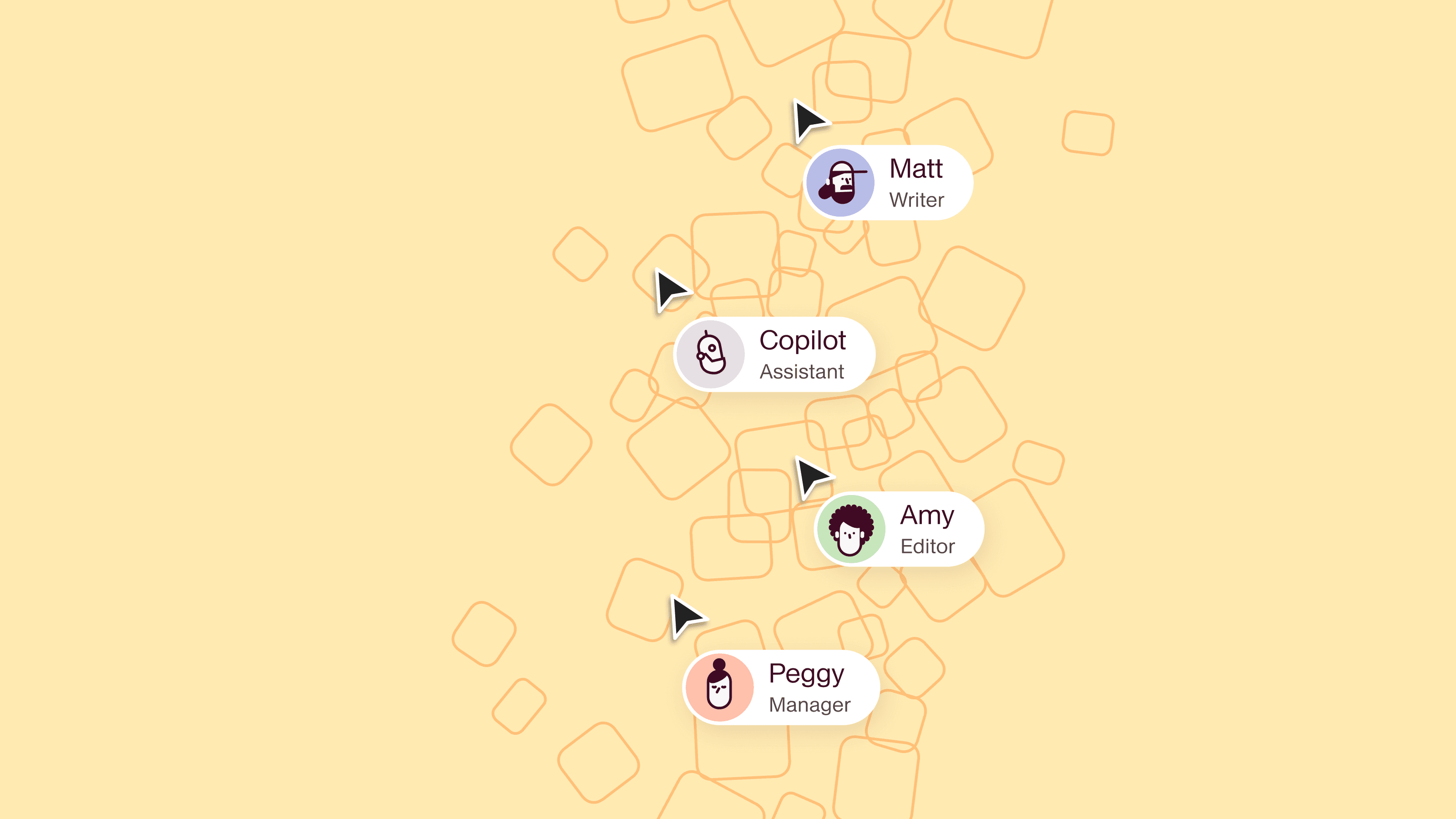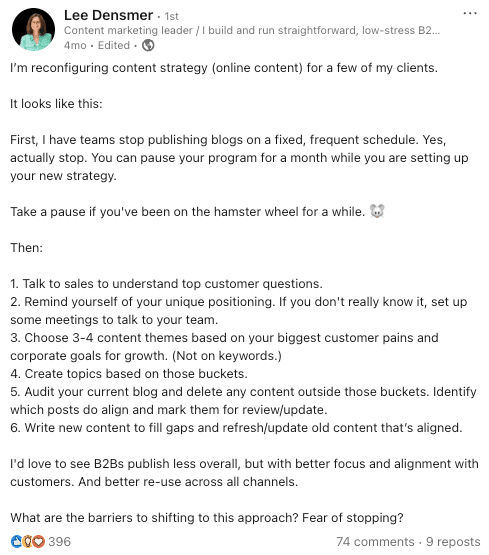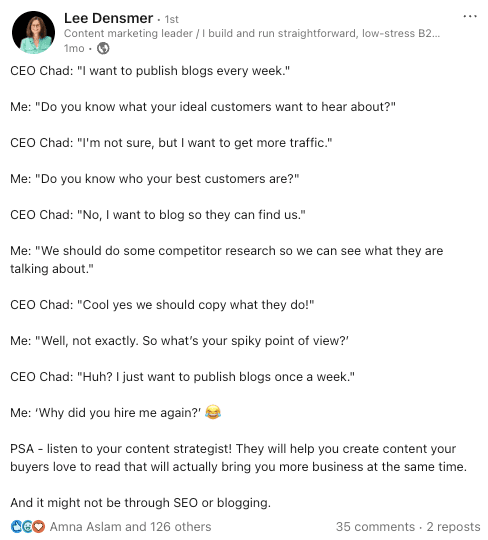How to Streamline Your Content Strategy (Without Losing Your Mind)
Most content advice assumes you’ve got a full team and endless time. You don’t. That’s why we asked Lee Densmer to share her 3x5 framework — built for high-output teams who need less chaos and more clarity.

You’re writing blogs, reviewing outlines, fielding Slack pings about that case study, and wondering when the new messaging doc is getting finalized. That doesn’t mean you’re doing it wrong. It means you’re in the thick of it.
Content teams tend to overextend, necessarily, because there’s pressure to generate leads like yesterday. One week you’re running five campaigns. The next, you’re building a new brand narrative in a Google Doc at midnight. But somewhere along the way, the strategy gets fuzzy.
That’s exactly the kind of overload Lee Densmer helps teams cut through. She’s a longtime content leader who’s built programs at fast-growing SaaS companies, and now helps others do the same with way less stress.
“When you’re buried in deadlines, it’s hard to zoom out and look at the strategy. But that’s usually when you need it most.” — Lee Densmer, Content Marketing Strategist at Globia Content Marketing.
That’s where Lee’s 3x5 framework comes in. It’s built for high-output, low-resourced teams that need more structure, and a lot less friction.
No jargon. No long sprints. No 93-slide strategy decks.Just five strategic decisions, made with intention.
“When you’re buried in deadlines, it’s hard to zoom out and look at the strategy. But that’s usually when you need it most.”
The 3x5 framework at a glance
Here’s what you need to lock in:
- 3 goals
- 3 buyers
- 3 themes
- 3 channels
- 5 metrics
Everything you create should point back to one of these 5 pillars. If it doesn’t, cut it.
For example, “You don’t need to boil the ocean. Just start with three buyers,” as Lee says.
This framework keeps your content grounded, focused, and tied to business outcomes.
Hit pause. Reset intentionally.

Sometimes the best next step is to stop. Briefly.
When you’re churning out content nonstop, burnout sneaks in. Strategy blurs. Deadlines pile up. Taking a short pause lets you step back and reassess what’s actually working and what’s just noise.
“There’s a fear that if we stop publishing, everything will fall apart. But in reality, nobody’s watching your blog that closely.”
“There’s a fear that if we stop publishing, everything will fall apart. But in reality, nobody’s watching your blog that closely.”
Pausing lets you catch your breath and make space for a better plan.
Here’s how to make that pause count:
- Be direct with leadership: “We’re pausing to realign with business goals.”
- Give it a time box: 2-3 weeks is usually enough.
- Set an outcome: Clear goals. Refined themes. A plan that doesn’t make your team want to quit.
Do a quick content audit
Before you start building again, take stock of what’s already live.
Look at the content (blog posts, ebooks, case studies, and so on) that you’ve published in the last 6 months. What still supports your goals? What aligns with your current themes?
No need for a giant spreadsheet. A simple keep/update/archive list will do.
Now it’s time to get into your 3x5 plan.
Define 3 goals (and actually use them)
It’s easy to list a dozen reasons for publishing content. But that’s how strategies turn into task lists. Lee’s advice? “Pick three goals. You can come up with 10, sure, but you’re not going to do 10 things well.”
“Pick three goals. You can come up with 10, sure, but you’re not going to do 10 things well.”
Here are some possible goals for your team:
- Build awareness
- Drive leads
- Influence pipeline
- Increase retention
- Grow traffic
Once you’ve got your three, tie each one to a clear metric (more on that below). If the goal is lead gen, what’s your signal of success? MQLs? Form fills?
This is how you keep your activities focused, not scattered.
Choose 3 buyers who drive your business
Start with revenue, not wishlist personas. Who’s signing contracts? Who’s in the room during sales calls? Who asks the questions your content should be answering?
Lee advises, “Start with the buyer roles that are most important to your business. The ones that have historically spent the most money with you. Not the ones with the loudest voice at the table.”
And skip the fancy labels. You don’t need to name them things like “Strategic Innovator Stacey.” You need to say “IT leaders” or “rev ops managers.” Keep it simple.
Quick ways to find them:
- Review the past 3 years of closed-won deals
- Ask your sales team who they talk to most
- Look at which roles move through your funnel fastest
Three buyers. That’s your target. Then, speak to them like real people with real problems. The rest is noise.
Identify 3 themes that map to buyer pain
Each buyer you picked? They’re facing a real problem. Those pain points = your themes.
Themes don’t need to be clever. They need to be useful. Think tactical problems like:
- Workflow automation to reduce friction
- Compliance
- Change management
- Saving money
- Reducing friction
- Reducing risk
“Most buyers have just a few key pain points. Start there. Don’t overthink it,” says Lee.
And if you’re stuck, ask: Do we want to be known for this? If the answer’s no, it doesn’t belong in your strategy.
Don’t create content for the sake of it. You want to be sure you are creating content on topics your buyers deeply care about and that will actually bring in more business.

Commit to 3 channels you can actually maintain
Don’t pick channels because you “should.” Pick the ones your audience already pays attention to.
Lee’s go-to mix is simple:
- Your blog
- A monthly newsletter
- Top social channel where your customers hang out; for B2B, it’s usually LinkedIn
- One optional lead magnet (quarterly is fine)
That’s enough to get reach, build consistency, and repurpose efficiently.
“Don’t pick channels because you ‘should.’ Pick them because they work.” — Lee Densmer
“Don’t pick channels because you ‘should.’ Pick them because they work.”
She makes a couple of other comments about these channels:
- If your blog is too top of funnel (TOFU), people will tune out. They can get those answers with ChatGPT.
- If your social is just ‘we are excited announcements’, your audience will struggle to care. Talk about their pains, like you do anywhere else.
- If your newsletter is a bullet list of blog links, that’s not a channel. That’s a missed opportunity.
“A newsletter shouldn’t just be a roundup of links. That’s lazy content. Treat it like its own channel with a distinct voice, useful insights, and content that helps your audience solve real problems, especially if they never click.”
Your buyers are busy. If they’re going to click, make it worth it.
Track 3 metrics per goal (and stop tracking the rest)
You don’t need a spreadsheet with 27 tabs.
“If your spreadsheet has 20+ metrics on it, you’re not going to track any of them well.”
Start with three. One for each business goal. That’s it.
Here’s a quick map to help you choose:
- Awareness → Social engagement
- Lead gen → MQLs
- SEO → Blog scroll depth
- Resonance → Email replies or click-through rate
- Pipeline impact → Opportunities influenced
These are the numbers that help you make decisions, not just report up.
“If your spreadsheet has 20+ metrics on it, you’re not going to track any of them well.”
How it all connects
Here’s what this looks like in practice:
- You choose a goal: Drive leads
- Your primary buyer: Operations leaders
- Their pain point: Scattered internal tooling
- Your theme: Workflow automation
You write a blog on automating repetitive tasks, promote it on LinkedIn, and recap it in your newsletter. Then you track how many leads came from that post.
That’s 3x5 in motion. Tight. Focused. Strategic.
Set a cadence that doesn’t burn you out
You don’t need to publish daily to be effective. You need a rhythm that doesn’t exhaust your team or fry your freelancers.
Lee’s minimum viable cadence:
- 2 blogs per month
- 3 LinkedIn posts per week
- 1 monthly newsletter
- 1 lead magnet per quarter
She shared, “This isn’t about content velocity, which is a thing of the past. It’s about building a rhythm you can actually stick to.”
You can get more mileage with less effort if you work smarter.
“This isn’t about content velocity, which is a thing of the past. It’s about building a rhythm you can actually stick to.”
Use AI strategically, not just frequently
Lee talks about how AI can help, but only when tied to goals and themes. For example:
“I love using AI to repurpose content, but only when there’s strategy behind it. Strategy means aligning AI reuse with your goals, themes, and buyer pain, not just rewording something to use elsewhere because you can. Without that connection, you’re just making more content nobody asked for.”
Smart ways to use it:
- Turn one blog into 10 LinkedIn posts
- Use ChatGPT to reformat content, not write it all
- Pull newsletter segments and reshare them on social after six months
The goal is to get more out of the work you’ve already done, not create more work.
Pro tip from Lee: Train a custom GPT on your 3x5 framework — your tone, buyer pains, and themes. Then treat it like your junior strategist. You can have individual GPTs for your newsletter, your social, or even brand imagery.
Make your workflow actually work
You’ve got your 3x5. Now make it usable for your team.
Even the best strategy stalls without a system. Lee’s advice? Use a project management tool to get organized and create a consistent, visible workflow.
You don’t need to get fancy. You need a place to track the real work.
As Lee puts it: “A chaotic content process will never get you the results you need and it’s hard on the people involved.”
Here’s a simple setup:
- Content calendar for active production: Track who’s working on what, when it’s due, and what type of content it is. Include fields like owner, format, persona, theme, and stage.
- Content catalog for everything that’s live: Move finished pieces here so you know what already exists and what’s being reused.
- Ideas board for intake and prioritization: Include a request form so stakeholders can give context. Move approved ideas into the production board.
- Strategic initiatives for bigger-picture efforts: This is where you track projects like updating personas or launching a new newsletter.
- Optional: Meeting board for standup agendas, team notes, and action items
Give your whole team access, including freelancers and agency partners. Keep it simple. Use the boards. Let them be your single source of truth.
Final word: Simplicity scales
Lee is a big fan of keeping it simple and often says, ‘Simple IS Strategic’.
You don’t need a giant content engine. You need a plan that gets the right work done, for the right buyers, in the right places.
And if you’re tired of managing strategy in spreadsheets and Slack threads?
Relato gives you one place to run your content operation — briefs, drafts, deadlines, and feedback — all in one workflow.
Try Relato free. Simplify your workflow, streamline your strategy, and finally breathe a little easier.